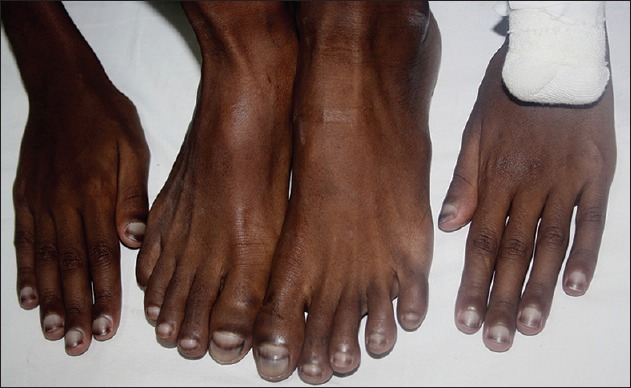A 10-year-old boy presented with brown-colored nails since the previous 3 months. He was a diagnosed case of chronic renal failure. The patient denied any history of nail trauma. He also denied history of any drug intake before the development of the lesion. Physical and developmental milestones were normal. Hematological investigations showed raised erythrocyte sedimentation rate with deranged renal function.
On nail examination all the 20 nails showed two distinct transverse bands with a brownish red band on the distal part of his nails and proximal white part of the nails having smooth surface and normal nail folds obscuring the lunula [Figure 1]. The demarcation line between the two transverse bands did not disappear on pressure. On the basis of clinical findings, a diagnosis of half and half nails was made.
Figure 1.

All the 20 nails showed distinct transverse band with the distal brownish red area and proximal white area of the nail plate
Half and half nail (brown arcs) is also known as Lindsay's nail, in which proximal portion of the nail is white and the distal half (20-60%) is reddish brown. Although it was first described by Bean[1] in 1963, Lindsay[2] was the first to coin the term half and half nail in 1967. Baran and Gioanni[3] were the first to correlate the half and half nail with renal disease and azotemia in 1968. It usually shows a sharp demarcation line between the two portions, which usually remains parallel to the distal free margin of the nail. There is no correlation between severity of azotemia and the distal band length. It is a rare but special clinical finding seen in chronic renal failure with a prevalence of 15-50%. It can also be seen in yellow nail syndrome, Crohn's disease, Kawasaki's disease, Behcet's disease, cirrhosis, hyperthyroidism, zinc deficiency, citrullinemia, pellagra, HIV infection, and even in healthy persons.[4]
The exact pathophysiology of half and half nails is not well understood. The proposed theory is that an increase in capillary density along with capillary wall thickening is responsible for the development of the half and half nail rather than an increase in melanocytes.[5]
Treatment is only cosmetic as this is a benign condition that requires only counseling and reassurance. The transition band usually remains unchanged even after dialysis but disappears completely after successful renal transplantation. It usually takes 2-3 weeks for disappearance.[4]
Footnotes
Source of Support: Nil
Conflict of Interest: Nil.
REFERENCES
- 1.Bean WB. Nail growth: A twenty-year study. Arch Intern Med. 1963;111:476–82. doi: 10.1001/archinte.1963.03620280076012. [DOI] [PubMed] [Google Scholar]
- 2.Lindsay PG. The Half-and-Half nail. Arch Intern Med. 1967;119:583–7. [PubMed] [Google Scholar]
- 3.Baran R, Gioanni T. [Half and half nail (equisegmented azotemic fingernail)] Bull Soc Fr Dermatol Syphiligr. 1968;75:399–400. [PubMed] [Google Scholar]
- 4.Iorizzo M, Daniel CR, Tosti A. Half and half nails: A past and present snapshot. Cutis. 2011;88:138–9. [PubMed] [Google Scholar]
- 5.Agrawal SK, Pandhi D. Idiopathic half-half nail. Indian J Dermatol. 2005;50:170. [Google Scholar]


